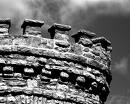- v50 information can now be added to pages in the main namespace. v0.47 information can still be found in the DF2014 namespace. See here for more details on the new versioning policy.
- Use this page to report any issues related to the migration.
Difference between revisions of "40d:Fortification"
m |
m (This article has no rating. Somebody please rectify it.) |
||
| Line 1: | Line 1: | ||
| − | {{av}} | + | {{av}} {{quality|unrated|11:19, 8 September 2010 (UTC)}} |
:''If looking for a guide on general fortifications as defense, see the {{L|Defense guide}} and/or {{L|Defense design}}. | :''If looking for a guide on general fortifications as defense, see the {{L|Defense guide}} and/or {{L|Defense design}}. | ||
Revision as of 11:19, 8 September 2010
| This article is about an older version of DF. |
- If looking for a guide on general fortifications as defense, see the Template:L and/or Template:L.
Fortifications are arrow slits used in the defense of your Template:L, (and which are more technically known as "crenellations"). They are probably most commonly used along the outside Template:Ls of your fortress and on the upper levels of constructed watchtowers so that Template:L and Template:Ls can fire at enemies from within your walls. Much like real world embrasures on battlements, their utility is limited if the enemy is close and at the same height; their true power lies in shooting from above and at distance, as it is possible to shoot at targets on other z-levels.
Fortifications allow ranged attacks (including Template:Ls), fireballs/breath, Template:L, Template:L, Template:L, etc. to pass through. Archers firing through fortifications must pass a skill test of some sort if they are not standing directly next to the fortification.[Verify] This test is more difficult from further distances.[Verify]
Building fortifications
Fortifications can be Template:L from stone walls, or built like any other Template:L. They cannot be carved from Template:L, though they can be constructed on soil, as described below.
Carving
Once you have chosen the wall you want to carve, Template:L the stone along its length using d -> s. After it has been smoothed, re-designate the same wall for fortifications using d -> a. Stone smoothing and fortification require a Template:L with the Template:L labor.
Built walls do not require smoothing before carving fortifications, regardless if they are smooth Template:L walls (built from stone blocks) or rough block walls (build from raw stone).
Damaged (i.e. partially mined) rock cannot be used for fortifications.
Construction
Fortifications can also be constructed from Template:L, Template:L, Template:L blocks, or Template:L (in lump or block form) using b -> C -> F. Construction of wooden fortifications require the Template:L skill, fortifications made of glass or stone require the Template:L skill, and those made of metal require Template:Ling.
Building fortifications does not include the floor on the level above. Constructing a wall and carving fortifications out of it does, however.
Uses and strategies
Fortifications are designed to allow your Template:L to make pincushions of your enemies without exposing themselves to the dangers of melee, and providing them with cover from return fire. Obviously, their utility is derived entirely from their placement. It's a good idea to place fortifications above the Z-level that they will be defending, because otherwise ranged enemies could conceivably stand directly outside them and receive no penalty from them. Raising them above ground makes them inaccessible to enemies.
It's helpful to make the room that the fortifications look out of a Template:L or Template:L, along with an Template:L Template:L, to ensure that there are always Template:L dwarves milling about at all times, ready to fire upon any attackers that threaten the fortress.
Fortifications can also be used to prevent creatures from swimming through your water/magma channels and into otherwise sensitive areas of your fortress. Do note, however, that Template:L has been observed to push creatures through fortifications even if they would otherwise not fit. Also, a fortification carved into a tile at the very edge of the map will allow water to drain through it and off of the map.
See also
| Rooms | |
|---|---|
| Furniture |
Animal trap • Anvil • Armor stand • Bed • Bin • Bucket • Cabinet • Cage • Coffin • Container • Restraint • Seat • Statue • Table • Weapon rack |
| Access | |
| Constructions | |
| Machine & Trap parts |
Axle • Gear assembly • Millstone • Screw pump • Water wheel • Windmill • Lever • Pressure plate • Trap • Support |
| Other Buildings | |
| Related Articles | |
